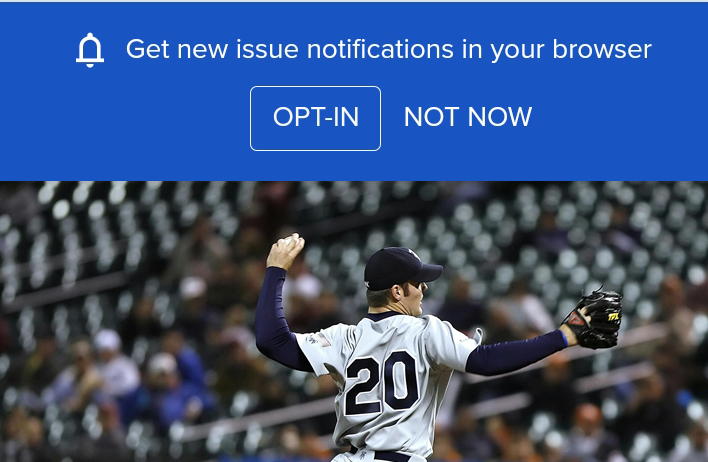On-the-go reading is great. No matter where your readers are physically—from the office breakroom to an airport terminal—they can access the best premium content and keep up with their favorite magazines.
But which format is the best? And how should you actually deliver your digital content, from a technical point of view?
In this article, we explore all things web-based magazines. We compare this type of tech to native apps to help you decide which is the best fit for your publication, audience, and budget.
Table of Contents
- What is a web-based magazine?
- How is this different than a mobile magazine app?
- What are the benefits of web-based magazines?
- 3 examples of web-based magazines
- When to choose a web-based magazine instead of building a mobile app
What is a web-based magazine?

A web-based magazine is a specific type of digital magazine that can be read in the web browser of any device, including computers, laptops, tablets, and mobile phones. Unlike a blog article or website, a web-based magazine is the digital version of a premium print magazine.
The content is laid out in a single column to be easy to read, with no pinching and zooming required (as is common with PDF magazines).
How is this different than a mobile magazine app?
Native mobile magazine apps, on the other hand, do not work inside a phone’s mobile browser are separate apps. Many popular magazines with large subscriber bases prefer to launch their own branded mobile app. This gives them a presence in app stores, so they can show up when people search for their name in the Apple App Store, Google Play, etc.
Without additional content and interactive features to support the need for a mobile app, there’s typically not a good case for publishers to build an app from scratch and maintain it.
Below, we share the benefits of web-based magazines. These benefits are a clear case against developing a native app.
What are the benefits of web-based magazines?
Web-based magazines are a much lighter lift when it comes to distributing content. Check out the top benefits for both publishers and readers.
What are the benefits of web-based magazines?
Web-based magazines are a much lighter lift when it comes to distributing content. Check out the top benefits for both publishers and readers.
Benefits for publishers:
- No need to maintain native apps – First and foremost, you won’t need to spend $10,000 – $20,000 monthly on mobile app development, maintenance, and testing. (The more operating systems you try to support, the higher those monthly costs will be, and the more you’ll save by opting for a browser-based magazine).
- More affordable – In terms of initial deployment and ongoing distribution, web-based magazines are far more affordable than mobile apps.
- Secure (no sharing) – Web-based magazines are not standard articles. Readers can’t share them with people who shouldn’t have access to your content. Only paying subscribers can read and open links, which we send via email notifications.
- Fewer customer support tickets – With no downloads or passwords required, you’ll receive far fewer support tickets. You don’t have to worry about answering questions about lost login credentials.
- Get more eyes on your back issues – This technology makes it easy to provide access to all the right issues for each subscriber. You can also sell back issues for an additional fee or provide access to all back issues for free.
Benefits for readers:
- No need to download an app – Readers don’t need to worry about cluttering their mobile devices with yet another app. Instead, they can click on the link in the email notification whenever a new edition gets published.
- Accessible and legible on any device – Web-based magazines look great on any device because they are truly mobile-optimized. They work on devices as large as desktop computers and as small as mobile phones. With white backgrounds, on-brand fonts, and single-column content, they provide a superior reading experience.
- No need for passwords – Readers don’t have to log in to a platform to read your content. They’re authenticated by clicking the link in the email notification. This removes frustration and all barriers between your readers and your content.
- Can access issues in one place – Using the web-based magazine reader, your subscribers can view all issues they have access to right there in their web browser, whether these are issues they’ve purchased or special editions you’re providing for free to active subscribers.
3 examples of web-based magazines
Ready to see what web-based magazines look like?
Check out these great examples, all evidence of the adaptability and quality of this format.
1. Esquire

This Esquire example shows readable, single-column content in a mobile device. Readers can click on the icon of the magazine cover to pull up the table of contents. They can then click on any article in the table of contents to be taken directly to it.
As you can see, Esquire’s branding is evident in the font style and colors.
2. Better Homes & Gardens

This example shows what it’s like to scroll through a web-based magazine article. You can also see an audio version at the top. eMagazines makes it easy to add high-quality, AI-generated article audio when publishing each new edition.
3. LOCAL Life

And lastly, you can see an example of LOCAL Life, an upscale magazine serving Hilton Head Island, Bluffton, and Beaufort. The content easily scales to fit a tablet, whether horizontal or vertical. The overall design is kept clean and simple so the content can shine.
When to choose a web-based magazine instead of building a mobile app
PDF magazines are never advisable because of the way that readers have to pinch and zoom their way around complex formatting. Print editions just don’t translate well online.
To create a great digital reading experience, you have two main options.
When it comes down to decision time, which should you choose—a web-based magazine or a mobile app?
Below, we make the decision very easy for you,
Choose web-based magazine technology if:
- You want to provide the most beautiful digital edition of your magazine without the need for downloads and passwords
- You want to save money on digital magazine distribution
- You don’t already have a successful native app
Choose to develop and maintain native apps if:
- You plan to release other content, experiences, and products in your app
- You already have a successful native app and you want to add a magazine to it
- Your audience expects you to have a branded native app
At eMagazines, we’re firm believers in the simplest solution for both publishers and readers. We’re happy to offer mobile magazine production, both through our web-based reader and native app development.



